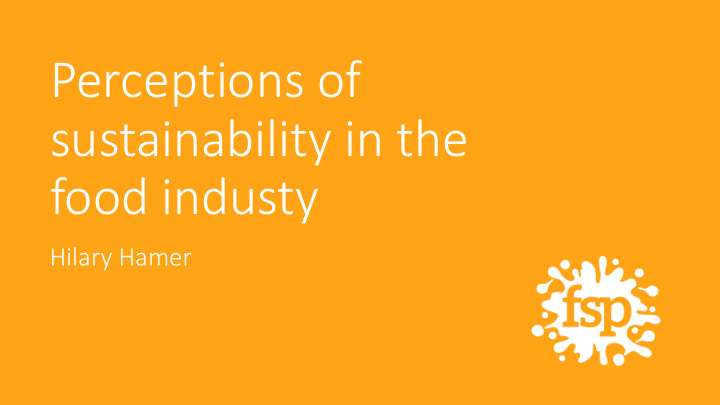



Perceptions of sustainability in the food industy Hilary Hamer
Agenda 1 Sustainability and the food industry 2 Reports 3 SME case studies 4 Reflections 2
Corporate view ”I see the key challenge as having to reconcile the inherently short -term nature of many aspects of society (consumerism, financial reporting, political cycles) with the long-term nature of sustainability. Costs today for uncertain benefits on an uncertain timescale are difficult to ‘sell’ in any event and the situation is compounded by the fact that the said uncertain benefits will often look very much like maintaining the status quo rather than anything recognisably new”. Gavin Milligan. Group Sustainability Director, William Jackson Food Group (Aunt Bessie’s, Jackson’s Bread, Abel and Cole, My Fresh, the Food Doctor). 3
2006 Food industry accounts for: DEFRA • about 14% of energy consumption by UK businesses and 7 Food Industry million tonnes of carbon emissions per year; Sustainability Strategy • about 10% of all industrial use of the public water supply; 2006 (2010 & 2015) • about 10% of the industrial and commercial waste stream; • 25% of all HGV vehicle kilometres in the UK; • the provision of food choices and information that will assist consumers to adopt more healthy and balanced diets; • 12.5% of the UK workforce. 4
IFST Food System Framework - a focus on food sustainability Using knowledge of food safety and other raw material risks to work with industry (e.g. FDF, Chilled Foods Association, WRAP, etc.) to identify how a broader set of environmental and social risks can be integrated into food business and supply chain risk management. Currently this is not being adequately addressed by the food industry. This could be achieved through inclusion of information and tools in GMP guidance, CPD and higher education courses. 5
Food Manufacture 2014 & 2016 http://www.foodmanufacture.co.uk/Products/S urvey-Report-State-of-the-UK-food-drink- manufacturing-sector-2016/(result)/go 6
LEAF Linking environment and farming “Whenever you see LEAF and the Soil Association in the same group, it will not necessarily secure the broader farmer engagement” 7
FDF’s Ambition 2025 shaping sustainable value chains McCain – generating electricity and reducing transport costs Apetito – halved factory food waste Pepsico – zero waste to landfill since 2011; waste from UK factories reduced by 33% in last 4 years Sainsburys - zero waste to landfill since 2012 Nestle – working on natural capital Ivan Woods and Son – water conservation through innovation
Sustainability and food security indicators 2015 - - Access to affordable and nutritious traded foods from local and regional producers to improve consumer food security and nutrition and enhance transparency in the food chain. - Access to markets and support to alternative markets (i.e. farmers’ markets, community supported agriculture) to improve livelihoods of both small-scale and larger scale producers. - Support local and regional food hubs and shorter value chains, and more broadly, efficient and functioning agricultural supply chains that link hinterland producers to market systems , to contribute to sustainable diets, reduce food waste along the chain and stabilise livelihoods in distribution, processing and manufacture of food and fibre products. - Protect and guarantee water, nutrients and energy resources, recover and reuse in agricultural production. - Create the conditions for participatory governance structures to include stakeholders from multiple sectors from both urban and rural areas. Prosperi, P.; Moragues-Faus, A.; Sonnino, R. and Devereux, C. (2015) Measuring progress towards sustainable food cities: Report of the ESRC financed Project “Enhancing the Impact of Sustainable Urban Food Strategies”. http://sustainablefoodcities.org/getstarted/developingindicators 9
Personal food industry Not ideal if you’re a pheasant 10
North Yorkshire Grouse Moors
Case study - meat Morley Hackford Village butcher Listed building Village growth reduced traditional customers Innovation Supply chain 12
Small scale livestock mixed farming High welfare High quality High social capital Community cohesion Sustainable 13
Case Study - fish Neil Davidson – buys fish from Grimsby market, van delivers 14
Case Study - shellfish GWS seafoods Family owned Only source shellfish from local boats with individual pots Tough market as costs high 15
Reflections Sustainability is all about survival - all the people I talk to – while expressing worthy concerns about the long term nature of environment, land, human health – cannot, of course, predict accurately what the next 50/100 years will bring. We have a sophisticated set of tools to give us an idea of direction of travel – many point to the urgent need to modify behaviour and consumption.
Recommend
More recommend